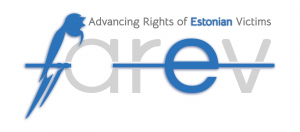
The objective of the AREV (Advancing Rights of Estonian Victims) Project is to enhance the rights of Estonian victims by improving the protection and support processes of victims of crime in the country. To achieve this goal, VSE works closely with the Estonian Ministry of Justice, the Police and Guard Board, the Social Insurance Board, the healthcare sector, and other key stakeholders to develop, deliver and test tools for the following three focus topics:
– information provision;
– individual needs assessment;
– and referral of victims.
Since the adoption of the 2012 EU Victims’ Rights Directive, Estonia has made significant progress on improving the rights, support, and protection of victims of crime. While the provision of state support was established in 2006, the 116 006 helpline for victims of crime has been operational since 2019, and 22 victim support offices, attached to police stations, were created in 2020. Yet, recent research, surveys, and assessment of the Directive show that a majority of Estonian victims of crime still do not receive the support they need.
Given the complexity of any victim centred response to crime, the wide-ranging needs of victims, and the multiple, diverse, agencies established in the region, it was recognised that an inclusive consultative approach, through a Community Needs Assessment (CNA), would be the most effective mechanism by which the stakeholders working with victims could improve their response.
With AREV aiming to introduce systemic changes, the project is being introduced in a pilot region before future implementation across Estonia. Following advice from the Executive Committee and Experts’ Panel, the Viru Region, in North-Eastern Estonia, has been selected for the pilot project. Specific tools will be developed, to support the authorities’ work in that region, regarding the three focus topics.
For each of the tools, this report will present requirements based on EU and Estonian legislation, European best practices, as well as identify, understand, and prioritise existing gaps in service provision within the target region or community, to better create an action plan to then develop tools that will address these shortcomings.
In addition, shortcomings and recommendations., concerning other topics of interest addressed and discussed during interviews, will be presented as well, to provide stakeholders with an understanding of any other gaps that have been identified. Some examples of shortcomings unveiled by the CNA are related to, but not only, the:
- lack of systematic approach for individual needs assessment of victims of crime;
- lack of training on the assessment of individual victims’ needs;
- lack of clear referral system and legal basis for referring victims’ contact details to victim support from the police;
- lack of victim identification, documentation and referral protocols, procedures and guidelines in hospitals and in health care institutions;
- insufficient visibility of victim support and explaining its presence and potential in the region, especially for the Russian speaking population: little available information also on the palunabi.ee page for Russian speaking specialists and victims;
- many websites used by victim support organisations to deliver information on their services are only available in Estonian or the translation is lacking in critically relevant information. Translation into Russian and English, which would be useful for citizens and tourists, are unavailable, making it almost impossible for victims not fluent in Estonian to access appropriate support.
Developing tools and mechanisms to better address the needs of victims of crime presupposes identifying and understanding those needs. To that end, the Community Needs Assessment is a strategic tool that can be used to identify, understand, and prioritise the needs of victims and of professionals supporting victims in the social, health, and law-enforcement sectors.

